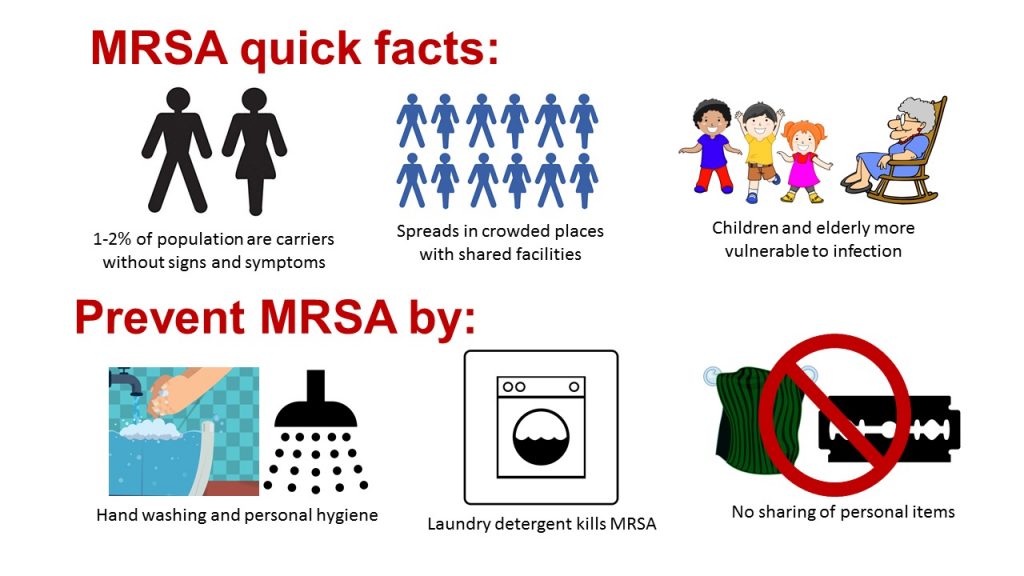MRSA: The superbug
By Assoc. Prof. Dr. Hui-min Neoh and Assoc. Prof. Dr. Toh Leong Tan, Universiti Kebangsaaan Malaysia

Massage, anyone?
“Stressful life” is the acronym for modern day living, including in Malaysia. Many people have different ways to de-stress, including running marathons, singing karaoke, chillaxing with friends at cafes and so on. Some opted for the therapeutic effect of going for a massage, which has been reported to improve blood circulation, reduce stress and improve sleep. In fact we see an upward trend in Malaysians seeking the services of masseurs, with the mushrooming of massage parlours and massage chair kiosks in the country. So, earlier this year, when the news of 20 people getting infected with the antibiotic-resistant superbug methicillin-resistant Staphylococcus aureus (MRSA) after massage sessions in an outlet at Kuchai Lama, Kuala Lumpur surfaced, the news went viral online. (https://www.worldofbuzz.com/20-people-suffer-contagious-bacterial-infection-after-visiting-massage-parlour-in-kuchai-lama/)
What is MRSA?
Most Malaysians have not heard about MRSA before, though many in the USA are wary of this bacteria. This is because in the 1980s and 90s, there were outbreaks of community-acquired MRSA (CA-MRSA) infections in young adults and children who have never been exposed to health or nursing-care facilities. Some of the CA-MRSA strains carry the Panton–Valentine leucocidin (PVL) toxin, which could cause necrotizing pneumonia in healthy individuals. Besides pneumonia, MRSA can cause a wide spectrum of infection: from simple skin infections to serious diseases such as osteomyelitis, endocarditis and even sepsis. Since 2017, MRSA has been listed in WHO’s “high priority” pathogen list for research and development of new antibiotics (https://www.who.int/news-room/detail/27-02-2017-who-publishes-list-of-bacteria-for-which-new-antibiotics-are-urgently-needed). Interesting fact: the Staphylococcus aureus bacteria was the first bacteria to become resistant towards penicillin just barely a few years after the launch of the antibiotic. And MRSA became resistant towards methicillin, the “magic bullet” of beta-lactam group of antibiotics, also just 2 years after its launch in 1959. Since then, MRSA strains have acquired resistance towards many classes of antibiotics, and are usually multi-drug resistant.
Situation in Malaysia
MRSA has been reported in Malaysia in the late 1980s, and it is mandatory for hospitals to report MRSA incidence to the Ministry of Health. Bacteriologists have started to determine the type of MRSA strains that are circulating in our country since 2008, though still somewhat on a small scale in different hospitals. Most studies performed on MRSAs isolated around 2005 – 2015 found the MRSA “ST239” strain to be the dominant strain (in Malaysia), carrying the antibiotic resistant cassette (what we call the SCCmec element) of SCCmec type IIIA-ccrC, which contains resistant determinants to methicillin (most beta-lactams group of antibiotics). The “ST239” is usually hospital-acquired (HA-MRSA), and carries with it genes encoding resistance to multiple classes of antibiotics. The strain has disseminated widely in the whole world, and has been isolated in all continents. Infections with this type of MRSA will cause difficulty in treatment, as limited options of effective antibiotics are available to clear the infection (as in the situation of some of the victims of the Kuchai Lama massage parlour outbreak).
What is being done?
In our laboratory, in 2009, we have determined the type of MRSA circulating in our university teaching hospital to be of the “ST239” strain, and sequenced the whole genome DNA of some representative isolates (Neoh et al., Genome Announc. 2013 Jan-Feb; 1(1): e00103-12)). By the naked eye, we can only identify bacteria when they grow in colonies on agar plates, and they will look similar even though they are from different strains or lineages. However, using DNA as a marker, scientists are now able to differentiate between MRSA strains, and to check if infecting strains carry virulent genes that code for toxins.
MRSA meets “CSI”: DNA never lies
Another interesting fact: usage of these DNA markers also enable us to trace transmission of a particular strain of bacteria between patients, and also to check for the originating source of the bacteria. A study we performed in 2013 allowed us to identify a particular MRSA strain which has been transmitted from patient to patient in our hospital’s ICU, and also from the patients to the immediate environment of their hospital cubicles, and vice versa (Ismail et al., Asia-Pacific Conference for Clinical Microbiology and Infection, 2014). Therefore, using the same technology, for the Kuchai Lama MRSA case, health authorities will be able to check if the victims were infected with the same strain of MRSA, if the MRSA really came from the massage parlour, and / or from one of the masseurs. All the investigator need will be swabs from the victims’ wounds, the attending masseurs’ hands and nose (MRSA can be carried in nasal cavities of healthy people without causing symptoms), and also swabs from environment of the massage parlour. MRSA could be cultured from these swabs, and with the comparison of DNA elements from these bacteria, transmission and source of the infection could be determined.
What next?
Identification of infection source, be it from the environment or human, will enable steps to be taken for eradication by decontamination (environment) with antiseptics, or antibiotic prescription (human). Human carriers of MRSA are usually prescribed the antibiotic mupirocin, which will clear the MRSA carriage in nasal cavity. Besides observing proper hand hygiene and cleaning of the massage parlour, periodic surveillance will be helpful to prevent similar episodes from recurring. Then, every trip to the massage parlour will indeed be a trip to de-stress and relax.
*Read more about the authors’ comments at https://view.joomag.com/the-health-march-2019/0530376001552465978

